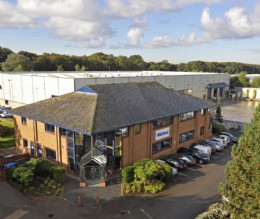Whitford UK’s Guide to Fluoropolymer Coatings


Preparing for a Better Finish
Each year, across industry, substantial amounts of both time and energy are wasted because the surface finish is not up to the required quality standard.
When it comes to pinpointing the cause; applicators, whether subcontractors or in-house finishing facilities, quite often point the finger at the coating. In the vast majority of cases this is unjustified and time after time the cause of failed or sub-standard finishes rests fairly and squarely with poor surface preparation or pre-treatments.
Thorough degreasing, detailed attention to surface preparation and meticulous standards of preparation are a pre-requisite to attaining a high quality, lasting finish.
Successful surface finishing should be just a matter of following the manufacturer’s recommended methods contained in datasheets and technical literature, yet a fair proportion of applicators still fall foul, with a desire to cut corners and save money or simple bad housekeeping as the principal causes.
In the worst cases some operators will try to cut a stage out of the process, such as gritblasting, altogether. Sometimes they ‘get away with it’, but on many occasions they don’t, with the desire to save a little eventually costing a lot due to rejected product having to be re-processed from square one, or in the worst cases, even scrapped.
When this happens and the applicator is handling work on sub-contract, it does little to engender trust or confidence for the manufacturer facing the prospect of lost stock and unfulfilled deliveries.
Where problems occur, a high proportion of the causes can be traced to deficiency either in method, materials or equipment somewhere along the line. By carrying out regular checks and following procedures through the processing stage, it is possible to pinpoint and eliminate problems.
So, taking things step-by-step, things to consider are:
Degreasing: Ensure that degreasants are not over used or contaminated. Degreasers are specially made chemicals for removal of grease and oils. These are generally solvent based, or contain solvents that have a dissolving effect on grease and other contaminants. They may also contain active ingredients such as surfactants. They may be used hot for greater solvency power through condensation and evaporation.
Alkaline and acid (pickling cleaners): These are usually used to remove grease and oils prior to plating and are usually part of a much wider process. Ensure the strength of cleaner will be tolerated by the component. For example, strong alkaline cleaners may be used for steel, but for zinc and aluminium a solution with much lower free alkalinity must be used. Always check with the manufacturer about the suitability of a cleaner for use with each metal.
Gritblasting: A crucial area where problems are most likely to occur. Don’t try to avoid gritblasting where it is recommended. It is an expensive process, but skipping it is false economy and a recipe for problems further down the line, such as poor adhesion.
Even though abrasive grit is costly, it needs to be changed regularly, as continued use alters the profile and size of the abrasive. At best a ‘tired’ grit will prolong the abrading process, at worst it could damage or destroy the product being treated by becoming embedded in the surface.
With gritblasting always ensure that the compressed air lines and equipment is checked for water and oil and drained DAILY to prevent contamination of the blast medium and guard against damaged or poorly finished product.
For Whitford’s Xylan® industrial coatings we recommend the use of 80/120 mesh aluminium oxide at about 80-100 p.s.i. to give a smooth surface finish of about eight microns on aluminium and four microns on steel. This provides the correct finish for a thin film coating of about 20-25 microns. Abrasives that are too savage for this type of application include steel shot, which has the effect of peening the surface, resulting in the coating failing on adhesion.
Phosphating: Using phosphates as a base coat provides a uniform texture with capillaries and microactivities into which the coating can key, providing a greater surface area onto which a coating’s adhesive forces can act. The adequate preparation of surfaces for phosphating is just as crucial as it is for applying industrial coatings direct to bare metal. Degreasing and gritblasting are needed to clean and activate the metal surface. Application of the industrial coating should be carried out within a few hours of phosphating to reduce the chances of the surface absorbing moisture or other contaminants detrimental to the surface coating.
Application: Final application of industrial coatings can give rise to a number of problems, which can easily be avoided with good housekeeping and best practice. Where coatings are spray-applied the spray area should be totally separate from dirty operations, such as gritblasting, to reduce the threat of airborne contamination. Spray areas should be enclosed and used for spraying only and ideally should have a balanced, controlled air supply.
Insufficient mixing of the coating material can also lead to poor results. Gravity is an uncompromising phenomenon and sooner or later solid particles suspended in the liquid coating will head for the bottom of the container.
If not thoroughly re-dispersed important active components will be missing from the dried film, reducing properties. One of the ‘key’ causes of coating failure identified on a regular basis is under-curing
due to the substrate not reaching the recommended temperature or where the temperature has not been maintained long enough.
For this reason, Whitford UK always recommends the use of thermocouples to ensure temperatures are substrate temperatures – the temperature of the metal – which should be monitored by linking the components to thermocouples during the curing cycle. Flash-off temperatures are also important as they ensure gradual heat up and even removal of solvents, preventing blistering and solvent boil.
By adopting and implementing best practice in surface preparation and pre-treatments, following the recommendations provided by manufacturers and ensuring that the coating applied is the best for a particular purpose, the threat of coatings failure can be easily avoided.
As a general rule – always read the instructions and if in doubt, ask!
Tel: 01928 571 000
Email: salesws@whitfordww.com
Web: www.whitfordww.com

| Telephone: | 01928 571000 |
| Email: | salesws@whitfordww.com |
| Website: | www.whitfordww.com |
| More information on the Whitford Ltd (PPG) BVAA Member Directory Page |
Search related valve / actuator articles: Whitford Ltd (PPG)Issue 44Company NewsSurface Coatings







-web.jpg)





